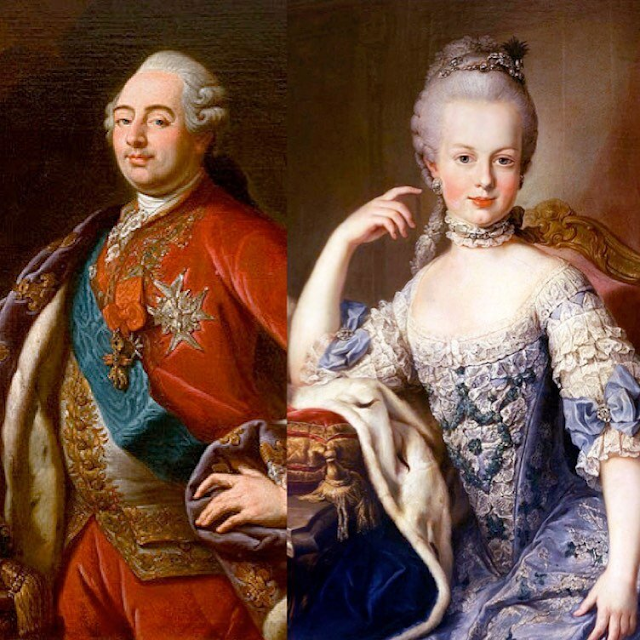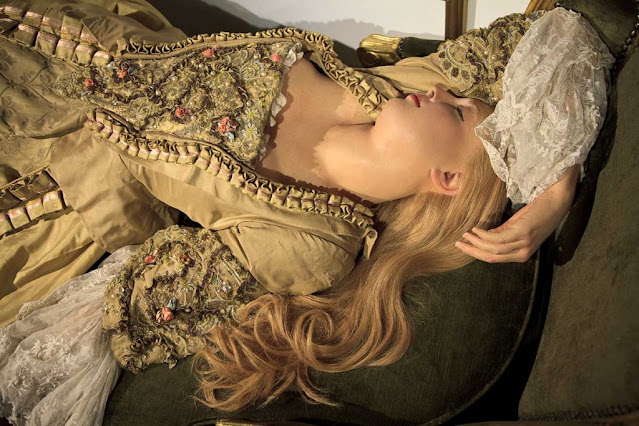A Mistress's Tale-Rag to riches
Madame du Barry, the last official
mistress of King Louis XV of France, was executed by guillotine in Paris at
approximately 50 years old.
She had lived quietly away from court since the King's death in 1774. Madame du Barry's end was not a dignified one; she screamed and pleaded for her life right up until the last moment.
It was a freezing cold December day and the
crowd was perhaps a little more thin than usual due to the weather and the
lateness of the hour but there were still enough people curious enough to see
the former King’s favourite die for there to be a sizeable mob gathered to
witness her execution.
The
life of Jeanne Bécu Du Barry (1743-1793) was a cautionary tale full of twists
and turns. Popularly known as the last mistress of Louis XV of France
(1710-1774).
Victim to the brutality of the French Revolution.
Madame
du Barry rose from modest origins to become one of the most powerful women in
France. But the glory didn’t last long as she later fell victim to the brutality
of the French Revolution. Let’s go through various roles that Jeanne Bécu Du
Barry played throughout her life.
 |
| Madame du Barry |
The illegitimate daughter of a seamstress and (possibly) a
monk
Jeanne Bécu Du Barry was
born as the daughter of a poor provincial seamstresses. In fact, she was an
illegitimate daughter and it is not known who her true father was. Her birth
name was Jeanne Bécu.
Her
mother, Anne Bécu, was a seamstress, while her father is usually presumed to be
a monk called Jean Jacques Gomard de Vaubernier.
Anne Bécu moved to Paris with her young
daughter in the company of Monsieur Billiard-Dumonceaux, a financier and
supplier to the royal army.
Dumonceaux
funded Jeanne’s education in a convent school for indigent or wayward girls run
by the nuns of Sainte-Aure.
As a
child, she was forced to work on the street as a sales girl. She grew into an
extremely attractive girl with blonde hair and almond-shaped blue eyes.
Jeanne
left the convent at the age of fifteen. She later served as a companion to an
elderly widow, Madame de Delley de La Garde, but was soon dismissed.
 |
| Madame de Pompadour |
When her youth and
beauty meddled in the marital affairs of La Garde's two sons. For a time,
Jeanne made her living by working in a haberdashery shop named 'À la Toilette'.
The Mistress of Jean-Baptiste Du Barry, a high-class pimp
In around 1763, she caught the attention of
Comte Jean Baptiste du Barry, a high-class pimp who owned a casino and made
Jeanne his mistress.
 |
| Comtesse du Barry |
Du
Barry made the young beauty firstly his own mistress – courtesan.
He
found her wealthy lovers and clients. As a courtesan, she became sensationally
popular in Paris and even the king’s ministers came to her.
Jean-Baptiste
du Barry noted that she could influence the king, so to this end he married her
to his brother – Count du Barry, and in that way she received the title and
could join the royal court.
saw
the huge potential of influencing Louis XV by installing Jeanne at court.
In order to make Jeanne maitresse-en-titre (the chief mistress of king of France), Du Barry had to give Jeanne a title.
 |
| Maria Theresa |
He
solved the problem by arranging a marriage between Jeanne and his brother,
Comte Guillaume du Barry. He even created a fake birth certificate that made
Jeanne a noble descent and listed her three years younger than she really was.
Official mistress of Louis XV
Until
this time, Louis’s official mistresses had been either of the highest
aristocracy or, in the case of Madame de Pompadour, of the highest ranks of the
moneyed class.
 |
| King Louise xv of France |
 |
| Madame de pompadour |
By the time Louis XV met
Madame du Barry, he was an old man in his late fifties.
Jeanne
was formally presented at Court on 22 April 1769. She was assigned luxuriously
appointed apartments in Versailles and other royal residences.
One
of her most famous rivals was Marie Antoinette Rival of Marie Antoinette
 |
| Versailles Palace of France |
Despite winning the heart
of the king, Jeanne had great difficulty to gain recognition from many other
nobilities due to her scandalous past.
One of her most famous rivals was Marie
Antoinette (1755-1793), daughter of Empress Maria Theresa of Austria. She
became Dauphine of France in May 1770 at age 14 upon her marriage to
Louis-Auguste (1754-1793).
 |
| Marie Antoinette |
Du
Barry and Antoinette first met each other in a family supper on the day before
the great wedding. Many thought Jeanne would not be included in the guest list
given her low origin but they were wrong.
Jeanne was invited to the exclusive event and stood out from the
rest of the crowd with her attractive extravagant appearance.
After learning that Jeanne’s role was to give pleasure to the
king, Antoinette was disgusted by the fact and refused to speak to her.
Marie Antoinette did not speak to du Barry
for a long time. After Maria Theresa of Austria learnt about the tension
between the two, she knew it couldn’t go on forever because Antoinette’s
marriage was still unconsummated, which means it could be annulled anytime and
jeopardise Austria's interests at the French court.
Therefore, Maria Theresa pressured her daughter to gain support
from the King by acknowledging Madame Du Barry.
At
the New Years’ reception on 1 January 1772, Marie Antoinette finally
surrendered. She casually turned to Jeanne and merely commented, ‘There are a
lot of people at Versailles today.’ It was enough for Madame du Barry, who was
satisfied with this recognition.
King Louis XV died of
smallpox in 1774
The
four years of her tenure as official mistress of the king were the highpoint of
Madame Du Barry’s life. After Louis XV died of smallpox in 1774, Jeanne Du Barry was disgraced
and banished from Court.
Last King of France Louise xvi and his queen Marie Antoinette
After the death of the
king, Du Barry was banished by order of Louis’s grandson and successor, King Louis
XVI.
After
a period of confinement in a convent, she lived in retirement at Luciennes,
where she was visited by new lovers, most prominent among them was, the
Governor of Paris.
Victim of the Reign of Terror during the French Revolution
As
the political situation in France deteriorated, Louis XVI was executed by
guillotine on 21 January 1793 on the Place de la Revolution.
The widowed former queen Marie Antoinette was
on trial in mid-October. She was convicted by the Revolutionary Tribunal of
high treason and executed by guillotine on 16 October 1793.
Denounced
for crimes of aristocracy and treason, du Barry was arrested on September 22,
1793. At first incarcerated in the prison of Sainte-Pélagie; she was later
transferred to the Conciergerie.
On 8 December 1793, Jeanne
Du Barry and her Flemish bankers, the Vandenyvers, father and two sons, were
executed. She became a famous victim of the Reign of Terror during the French
Revolution.
The End
Disclaimer–Blogger has prepared this short write up with help of materials and images available on net. Images on this blog are posted to make the text interesting.The materials and images are the copy right of original writers. The copyright of these materials are with the respective owners.Blogger is thankful to original writers.










No comments:
Post a Comment